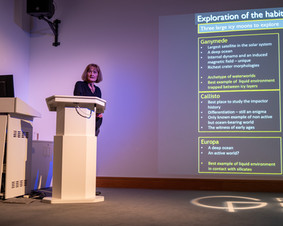JUICE, the ESA spacecraft mission to Jupiter’s icy moons by Professor Michele Dougherty
- Paul May
- Feb 12, 2024
- 3 min read
Updated: Feb 13, 2024
Astronomy homework
Mike presented the Sky this Month to kickoff the meeting. Highlights include: the conjunction of the first quarter moon with the Pleiades this Friday evening (16th February); the comet 144P/Kushida which is moving away from Aldebaran, the eye of the bull, along Taurus's easterly horn; and finally M44 the Beehive Cluster and one of Mike's favourite night sky objects.
To boldly go ..
Barry then introduced Professor Michele Dougherty FRS, our main speaker for the evening, and the principal investigator for the magnetometer instrumentation on the JUpiter ICy moons Explorer (JUICE) mission which successfully launched last April.

Career defining moments
To paraphrase Newton, the JUICE mission stood on the shoulders of previous giants, the Galileo and Cassini missions. The former, launched 35 years ago, provided hints of sub-surface liquid water in the 3 outer Galilean moons namely Europa, Ganymede and Callisto. The Cassini mission, launched over 25 years ago, targeted Saturn and selected moons. Most pertinently, 10 years after launch, it was scheduled to flyby Enceladus 3 times. Anomalous magnetic field data detected by Michele's on-board magnetometer indicated the presence of water vapour. She persuaded NASA to undertake a much closer third flyby at the moons south pole. Bingo! Huge water plumes were observed, emitted from a sub-surface ocean through 'tiger stripe' cracks in the surface.
ET on our doorstep
The discovery of liquid sub-surface oceans on Enceladus and the three icy Galilean moons, combined with the discovery of primitive unicellular life in very inhospitable environments on our own planet, led to an incredible conclusion. Maybe life, albeit in basic form, existed in our own solar system! And thus began the long process of persuading ESA to launch a mission to specifically visit some of these habitats.

Elusive needles in a haystack
The focus of the JUICE mission is the exploration of Ganymede, the solar systems largest moon (larger than Mercury!). ESA's spacecraft will flyby Europa and Callisto before orbiting Ganymede. Michele's key magnetometer instrument will be looking to characterise the sub-surface salty oceans through perturbations in the magnetic field. This is a very challenging third order effect to measure with the fields dominated in the first instance by Jupiter's own huge field and then to a much lesser extent by Ganymede's own field which is generated by a molten core. These fields will generate a current in the salty ocean producing a very small magnetic fluctuation which Michele's baby (I mean magnetometer!) is designed to measure.

Shake and bake
Significant pre-launch testing must take place to ensure that Imperial College's key instrument can survive the launch. After a non-intentional test to destruction, a more robust upgraded version survived the rigorous shaking and baking. And despite the difficulties presented by COVID delays, the JUICE spacecraft launched successfully from Kourou last April. A couple of months later, the magnetometer boom was perfectly deployed. Now we just have to wait another 7 years for the mission to reach the Jovian system, where she will be joined by NASA's Europa Clipper!
Thank you, Michele, for an inspirational and fascinating talk enjoyed by all present ('best of the season', a common refrain). And for having the necessary combination of determination, grit, diplomacy and patience required for these long timescale science experiments. Please come back again in 2031 to give us an update!















